Anatomical Study of the Nerve Supply of the Dromedary Camel (Camelus dromedarius) in the Distal Hindlimb with a Special Reference to the Cutaneous Innervation
Abstract
Simple Summary
Abstract
1. Introduction
2. Materials and Methods
3. Results
3.1. Superficial Fibular Nerve (N. fibularis superficialis)
- The axial dorsal proper digital nerve of the III digit (N. digitalis proprius dorsalis III Axialis) continues along the medial surface of the third III digit (Figure 3(7)).
3.2. Tibial Nerve (N. tibialis)
3.3. The Lateral Plantar Branch (N. lateralis plantaris IV)
4. Discussion
5. Conclusions
Author Contributions
Funding
Institutional Review Board Statement
Informed Consent Statement
Data Availability Statement
Acknowledgments
Conflicts of Interest
References
- Guimarães, G.C.; Machado, M.R.F.; Santos, A.L.Q.; Vieira, L.G.; Souza, A.G.; Silva, J.M.M.; Kaminish, P.S. Origem e distribuição do nervo isquiático no gato doméstico (Felis catus domesticus, Linnareus, 1758). Biosci. J. 2005, 21, 189–195. [Google Scholar]
- Getty, R. Sisson and Grossman’s: Anatomy of the Domestic Animals, 5th ed.; W.B. Saunders: Philadelphia, PA, USA, 1975. [Google Scholar]
- Cruz, V.S.; Cardoso, J.C.; Araújo, L.B.M.; Souza, P.R.; Silva, M.S.B.; Araújo, E.G. Anatomical aspects of the nerves of the leg and foot of the giant anteater (Myrmecophaga tridactyla). Arq. Bras. Med. Vet. Zootec. 2014, 66, 1419–1426. [Google Scholar] [CrossRef]
- Moraes, D.V.; Martins, J.D. Silva FOC, Drummond SS, Severino RS. Origem e distribuição do nervo femoral em equinos sem raça definida. Horiz. Científico 2008, 1, 1–10. [Google Scholar]
- König, H.E.; Liebich, H.J. Anatomia dos Animais Domésticos; Artmed: Porto Alegre, Brazil, 2004; Volume 2, 399p. [Google Scholar]
- Gilroy, A.M.; Macpherson, B.R.; Ross, L.M. Atlas de Anatomia; Guanabara Koogan: Rio de Janeiro, Brazil, 2008; 656p. [Google Scholar]
- Campos, D.; Silva, F.O.C.; Severino, R.S.; Drummond, S.S.; de Lima, E.M.M.; Bombonato, P.P.; Santana, M.I.S. Origem e distribuição dos nervos isquiáticos em fetos de bovinos azebuados. Ars Vet 2003, 19, 219–223. [Google Scholar]
- Lima, E.M.M.d.; Silva, F.O.C.E.; Severino, R.S.; Drummond, S.S.; Campos, D.B.; Santana, M.I.S.; Moraes, D.D.A. Origem e distribuição dos nervos isquiáticos em caprinos da raça Saanen. Ciência Rural 2008, 38, 372–377. [Google Scholar] [CrossRef]
- Moraes, D.V. Origem E Distribuíção do Nervo Femoral em Eqüinos Sem Raça Definida. Horiz. Científico Uberlândia 2014, 30, 1469–1501. [Google Scholar]
- Lizardo, F.B.; Silva, F.O.C.; Awori, K.O.; Severino, R.S.; Guimarães, E.C.; Santos, L.A.; Eulálio, F.H.F.; Sousa, G.C.; Facury Neto, M.A.; Júnior, R.B.; et al. Origin and distribution of the femoral nerve in fetuses of zebu-crossed bovines. J. Morphol. Sci. 2017, 26, 91–96. [Google Scholar]
- Oliveira, G.B.d.; Rodrigues, M.N.; Sousa, Ê.S.; de Albuquerque, J.F.G.; de Moura, C.E.B.; Ambrósio, C.E.; Miglino, M.A.; de Oliveira, M.F. Origem e distribuição dos nervos isquiáticos do preá. Ciência Rural 2010, 40, 1741–1745. [Google Scholar] [CrossRef]
- Silva, F.O.C.; Brito, T.R.; Vasconcelos, B.G.; Canabrava, H.A.N.; Pereira, C.C.H.; Nolasco, R.M.; Honorato, A.d.G.d.O. Origens e distribuições dos nervos femorais em ovinos sem raça definida. Biosci. J. 2011, 27, 978–981. [Google Scholar]
- Nickel, R.; Schummer, A.; Seiferle, E. The Anatomy of the Domestic Animals; Springer: Berlin/Heidelberg, Germany, 1973; p. 1052. [Google Scholar]
- Dyce, K.; Sack, W.; Wensing, C. Textbook of Veterinary Anatomy, 4th ed.; Saunders/Elsevier: St. Louis, MO, USA, 2010; Volume 71, p. 78. [Google Scholar]
- Smuts, M.M.S.; Bezuidenhout, A.J. Anatomy of the Dromedary; Oxford University Press: Oxford, UK, 1987; pp. 87–90. [Google Scholar]
- Budras, K.-D.; Habel, R.E. Bovine Anatomy; Schlütersche Verlagsgesellschaft GmbH and Co. KG: Hanover, Germany, 2011; pp. 9–23. [Google Scholar]
- Budras, K.D.; Sack, W.O.; Horowitz, A.; Berg, R. Anatomy of the Horse; Schlütersche Verlagsgesellschaft GmbH and Co. KG: Hanover, Germany, 2013; pp. 3–25. [Google Scholar]
- Miller, M.E. Anatomy of the Dog; W. B. Saunders: Philadelphia, PA, USA, 1964; p. 941. [Google Scholar]
- Martin, W.; Bartholomew, G. Essentials of Anatomy and Physiology, 3rd ed.; Pearson: London, UK, 2019; p. 421. [Google Scholar]
- Tempest, D.H. Anatomical Techniques, 2nd ed.; Roy Collage of surgeons of England Edinburgh and London: London, UK, 1980; pp. 126–127. [Google Scholar]
- Erden, H. Merkebin (Equus asinus L.) plexus lumbosacralis’I üzerinde makroanatomik ve subgros çalişmalar. S. Ü. Vet. Fak. Derg. 1993, 9, 64–71. [Google Scholar]
- Lorenz, M.D.; Kornegay, J.N. Neurologia Veterinária, 2nd ed.; Manole: Barueri, Brazil, 2006; p. 467. [Google Scholar]
- El-Shaieb, M. Topography of the nerves of the hind limbs of the camel (Camelus dromedarius). Assuit Vet. Med. J. 1976, 3, 13–24. [Google Scholar] [CrossRef]
- Al-Sadi, S.; Alosh, G.; Al-Omari, A. Arterial, nerve supply and venous drainage of tendons with sheath and suspensory ligament to the distal part of limbs in camels. Al Baath Univ. J. 2008, 30, 53–76. [Google Scholar]
- Al-Sadi, S.; Alosh, G.; Al-Omari, A. Arterial and nerve supply and venous drainage of extensor and flexor digit tendons with sheath and suspensory ligament to the distal part of limbs in buffalo. Iraqi J. Vet. Sci. 2009, 23, 137–144. [Google Scholar]
- Maher, M.; Emam, I. Normal vascular and nerve distribution of the pes region in dogs: An anatomical and diagnostic imaging. Int. J. Vet. Sci. 2020, 9, 259–266. [Google Scholar]
- Schummer, A.; Wilkens, H.; Vollmerhaus, B.; Habermehl, K.-H. The Circulatory System, the Skin, and the Cutaneous Organs of the Domestic Mammals; Springer: Berlin/Heidelberg, 2013. [Google Scholar]
- Medina Puentes, R.; Muñoz, P.M.; Albornoz, I.C.; González, C.B. Descripción anatómica de la inervación del miembro pélvico de león africano (Panthera leo). Int. J. Morphol. 2014, 32, 889–894. [Google Scholar] [CrossRef]
- Dayer, T.; Rohrbach, H.; Forterre, S.; Stoffel, M.H.; Forterre, F. Investigation of sciatic nerve surgical anatomy in dogs and cats: A comparative cadaveric study. Int. J. Vet. Sci. 2017, 6, 131–135. [Google Scholar]
- Getty, C. “Bony sciatica”—The value of thermography, electromyography, and water-soluble myelography. Clin. Sport. Med. 1986, 5, 327–342. [Google Scholar] [CrossRef]
- Evans, H.; De Lahunta, A. Millers Anatomy of the Dog; Elsevier: St. Louis, MO, USA, 2013. [Google Scholar]
- Ghoshal, N.; Getty, R. Innervation of the forearm and foot in the ox (bos taurus), sheep (ovis aries) and goat (capra hircus). Iowa State Univ. Vet. 1967, 29, 19–29. [Google Scholar]
- Levine, J.M.; Levine, G.J.; Hoffman, A.G.; Mez, J.; Bratton, G.R. Comparative anatomy of the horse, ox, and dog: The vertebral column and peripheral nerves. Equine Comp. Cont. Educ. Pract. Vet. 2007, 2, 279–292. [Google Scholar]
- Hassan, A.; Talozi, M. Clinical Anatomy Upper and Lower Limbs, 6th ed.; Damascus Press: Novi, MI, USA, 2007; p. 2. [Google Scholar]
- Pasgunich, S.I. Anatomy of Domestic Animals Systemic and Regional Approach, 7th ed.; Sndz Publishing: Tioga, TX, USA, 2009; p. 415. [Google Scholar]
- Wang, J.-L.; Wang, G.-X.; Li, H.-Y. The arterial supply to the digits of the forelimb in the Bactrian camel (Camelus bactrianus). J. Anat. 2000, 196, 193–202. [Google Scholar] [CrossRef]
- Elmore, R.; Elmore, R. Food-animal regional anesthesia. Bovine blocks: Paravertebral lumbar anesthesia. Vet. Med. Small Anil. Clinic. 1980, 75, 82. [Google Scholar]
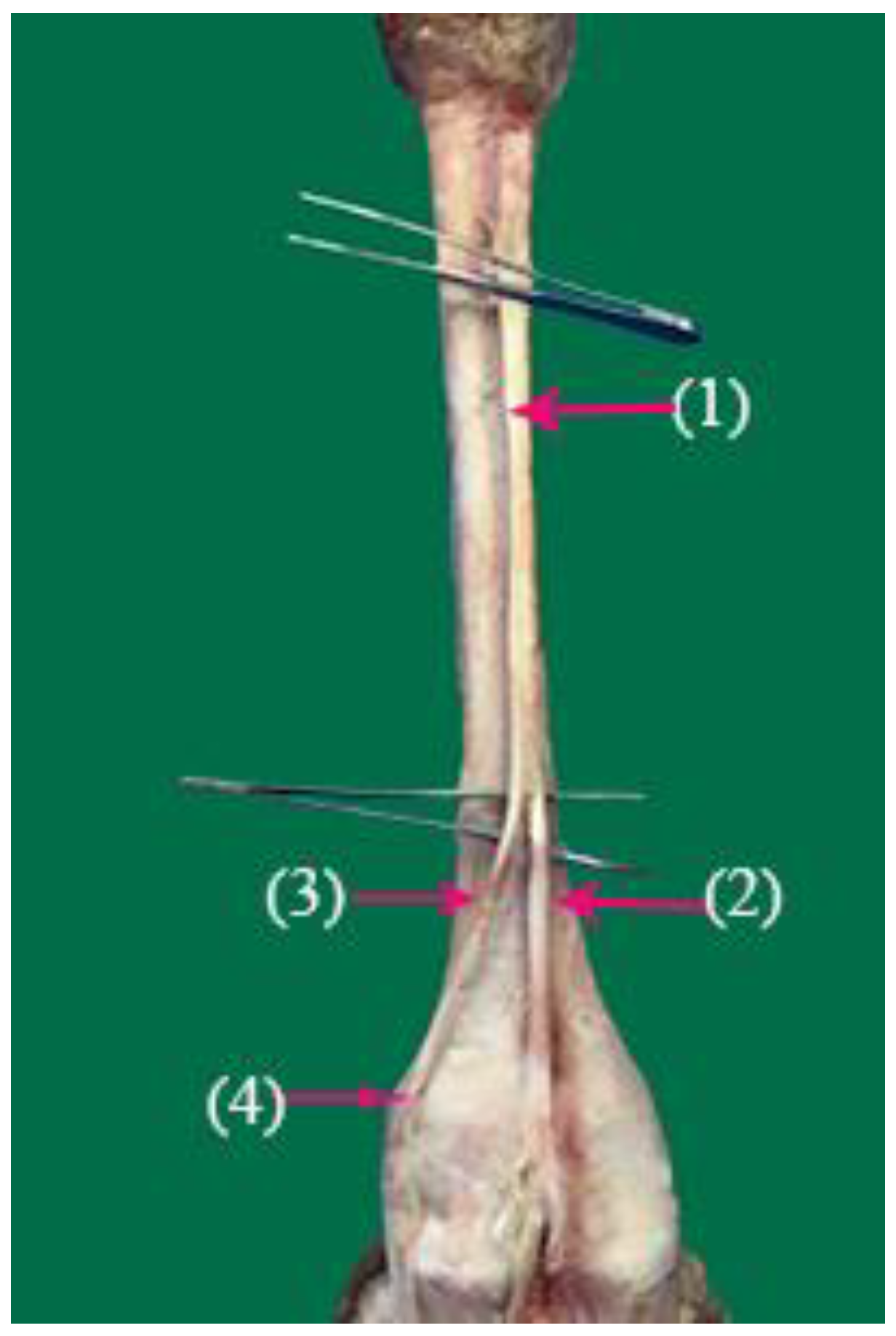
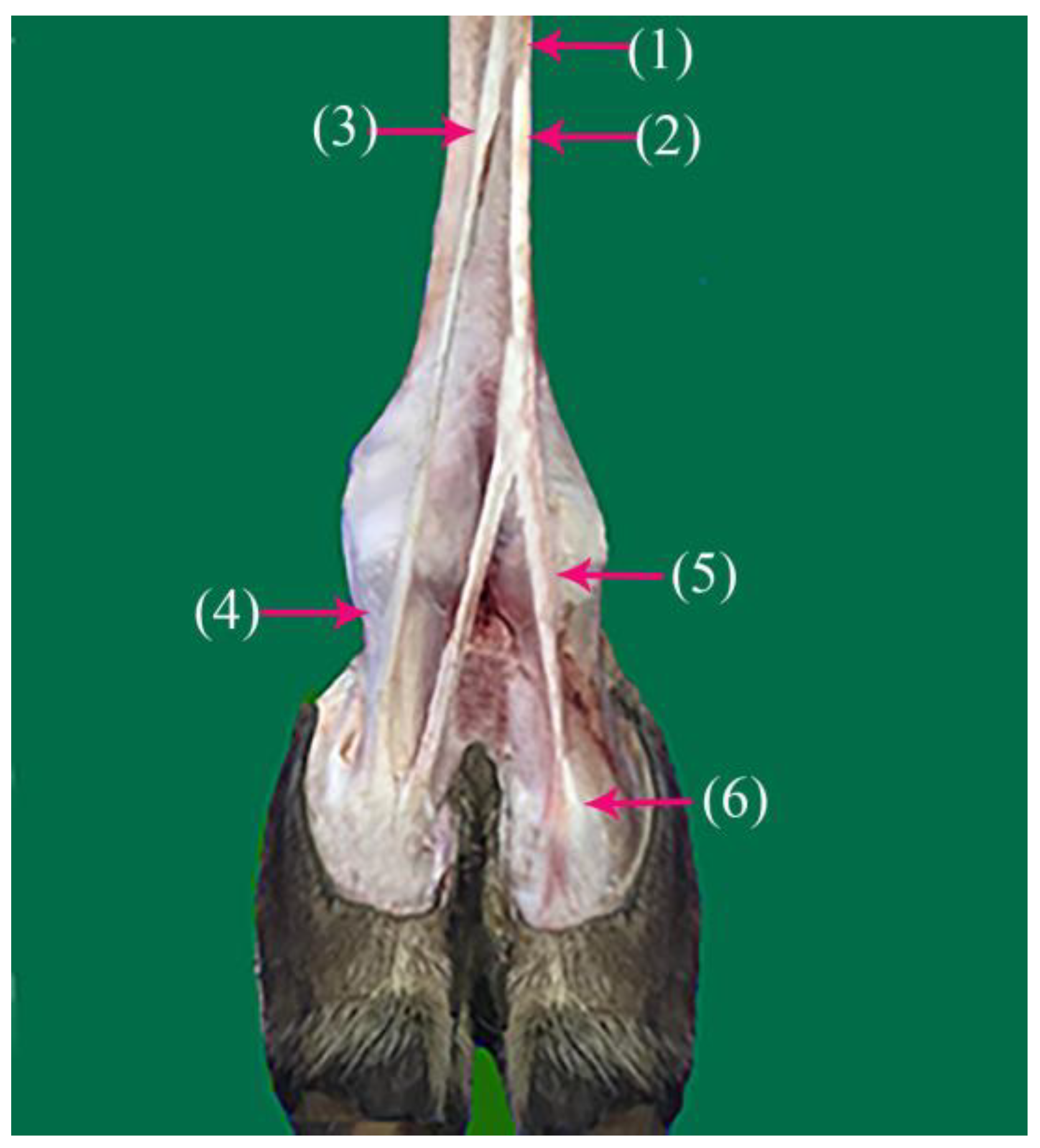
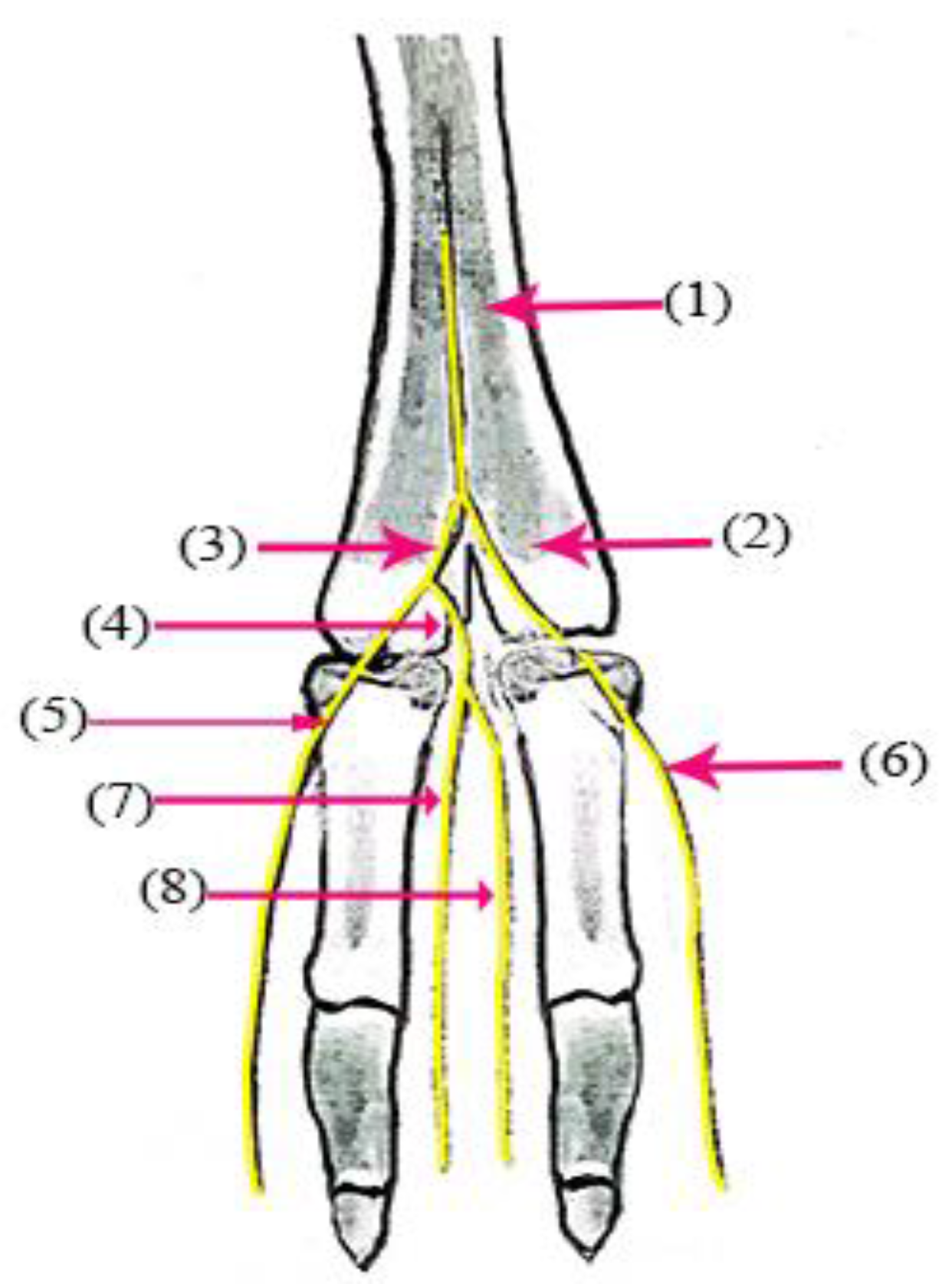


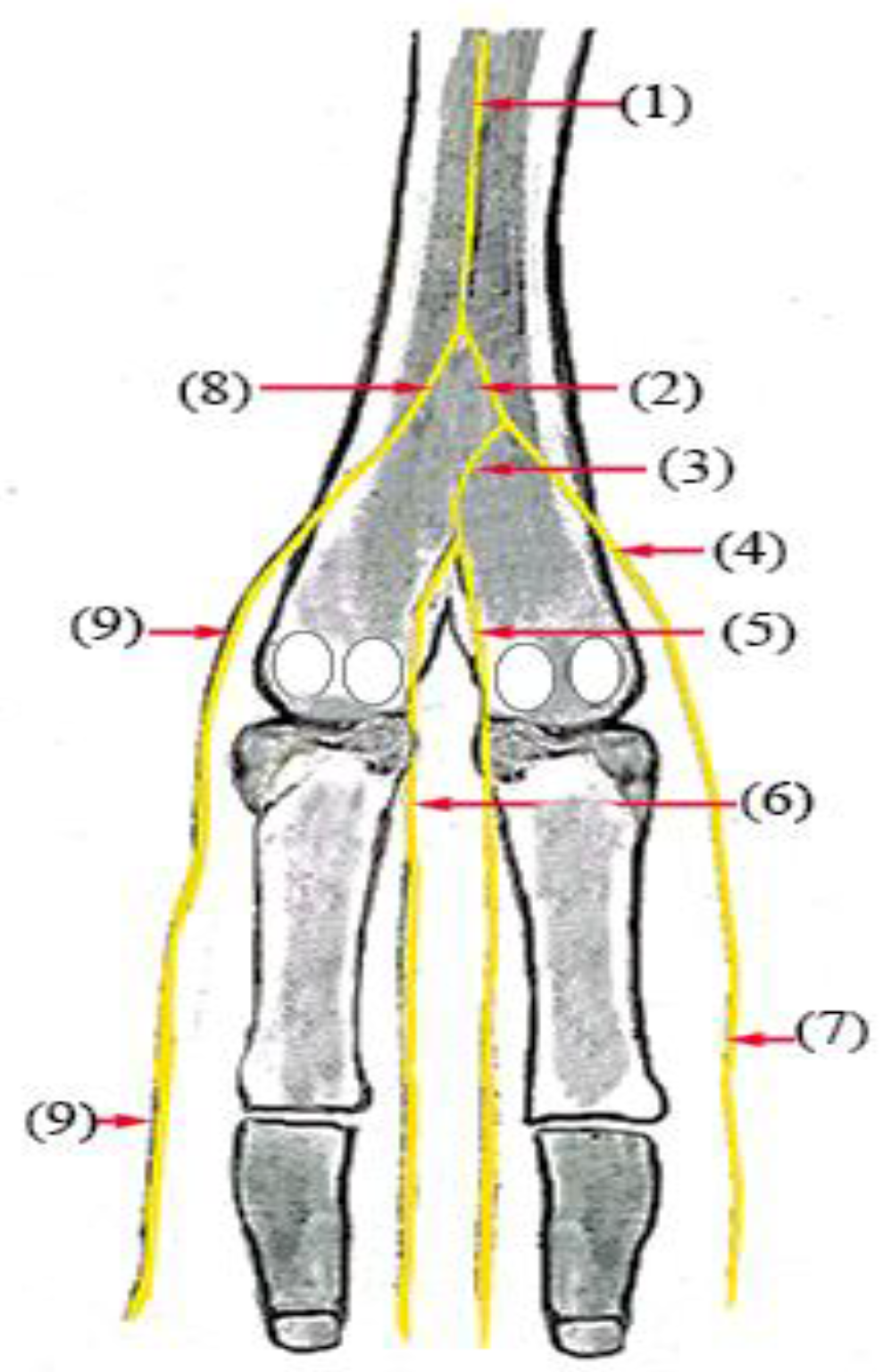
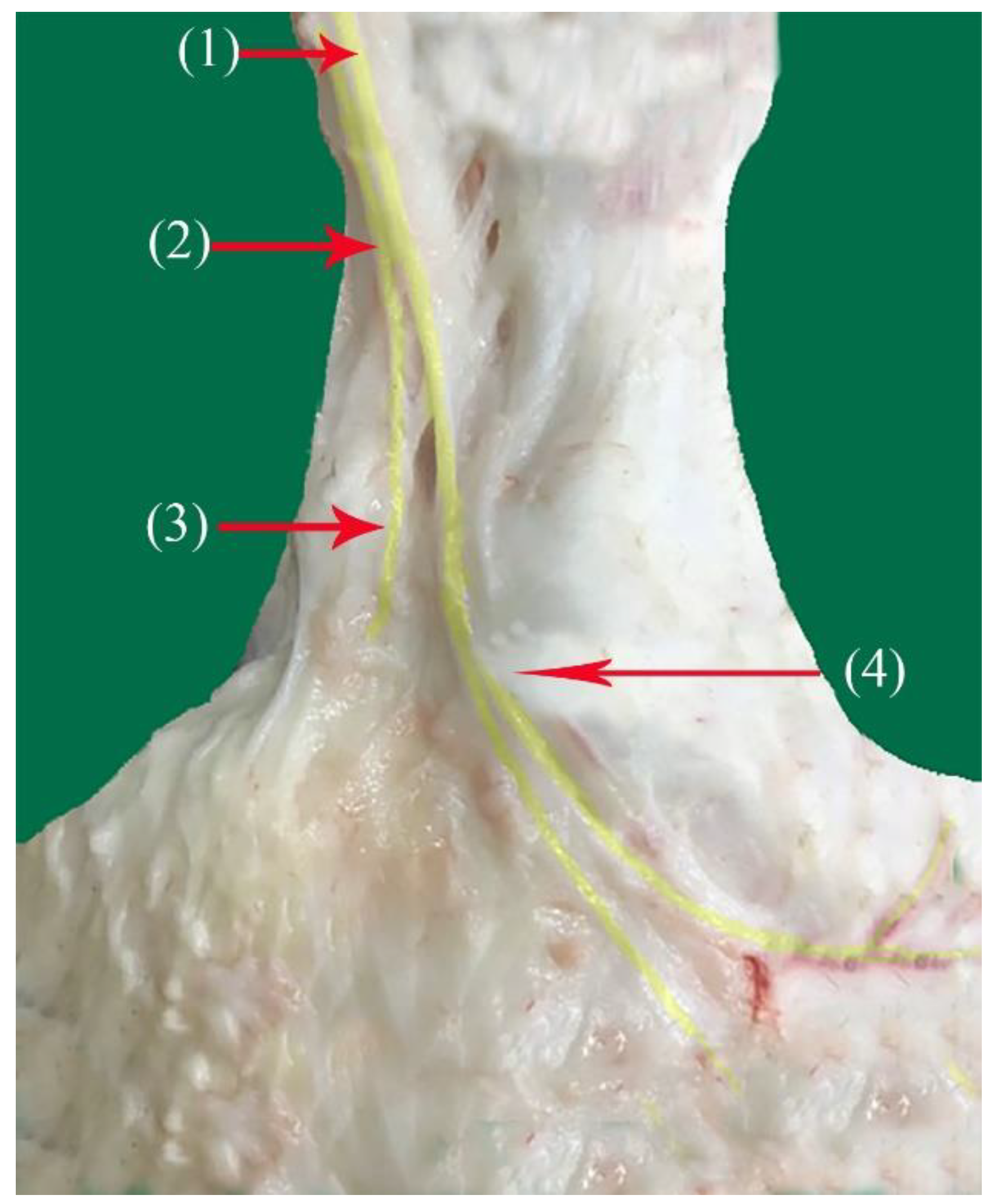
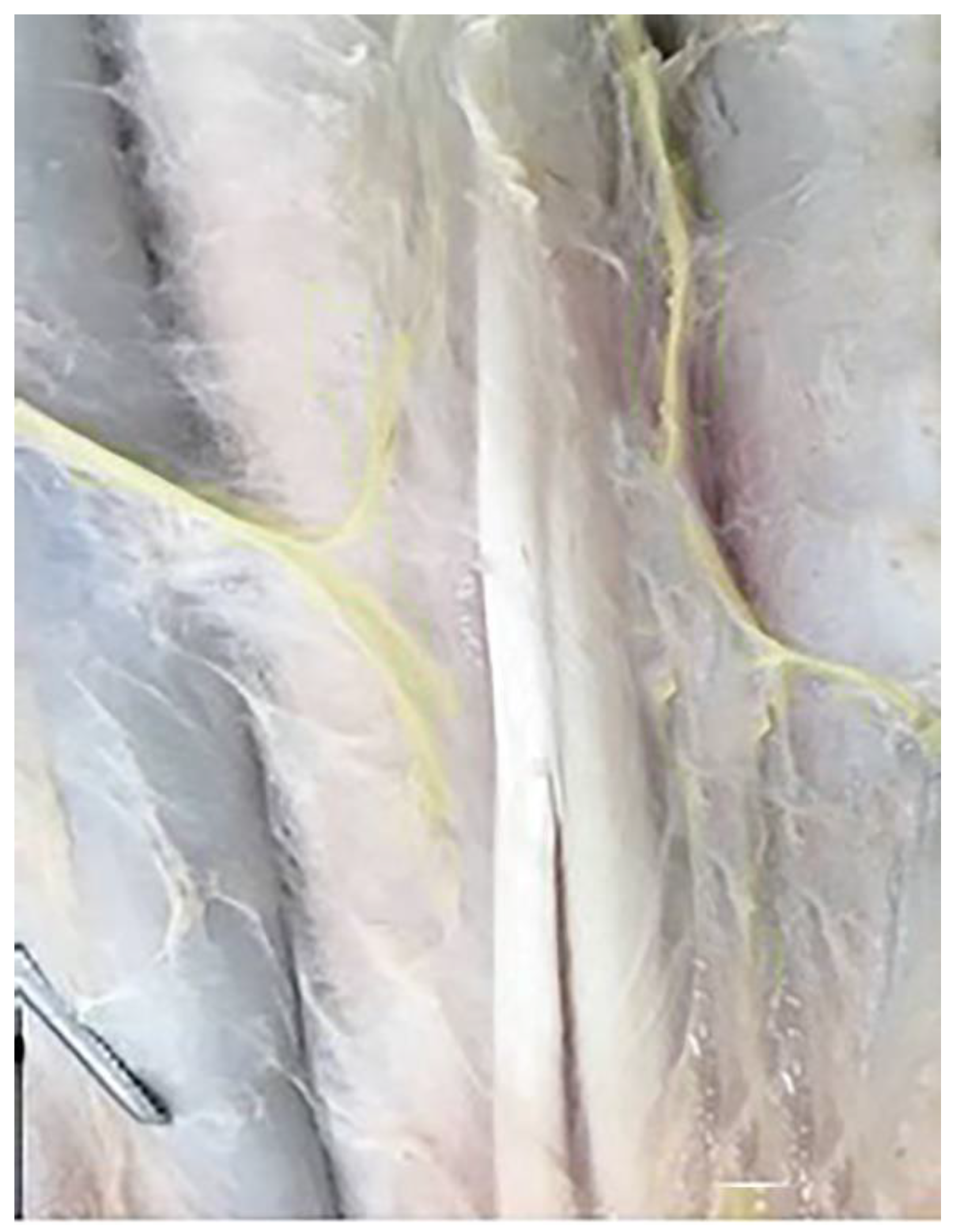
 Dorsal surface of the III and IV digits.
Dorsal surface of the III and IV digits. Lateral surface of the metatarsus of the IV digit.
Lateral surface of the metatarsus of the IV digit.  Medial surface of the metatarsus of the III digit.
Medial surface of the metatarsus of the III digit.  Abaxial surface of the IV digit.
Abaxial surface of the IV digit.  Axial surface of the III digit.
Axial surface of the III digit.  Caudo-plantar surface of the IV digit.
Caudo-plantar surface of the IV digit.
 Dorsal surface of the III and IV digits.
Dorsal surface of the III and IV digits. Lateral surface of the metatarsus of the IV digit.
Lateral surface of the metatarsus of the IV digit.  Medial surface of the metatarsus of the III digit.
Medial surface of the metatarsus of the III digit.  Abaxial surface of the IV digit.
Abaxial surface of the IV digit.  Axial surface of the III digit.
Axial surface of the III digit.  Caudo-plantar surface of the IV digit.
Caudo-plantar surface of the IV digit.
 Lateral and latero-plantar aspect innervation by the abaxial lateral tibial nerve of the III and IV digits.
Lateral and latero-plantar aspect innervation by the abaxial lateral tibial nerve of the III and IV digits.  Dorsal aspect innervation by the superficial fibular nerve of the III and IV digits.
Dorsal aspect innervation by the superficial fibular nerve of the III and IV digits.  Medial and medio-plantar aspect innervation by the axial medial tibial nerve of the III and IV digits.
Medial and medio-plantar aspect innervation by the axial medial tibial nerve of the III and IV digits.
 Lateral and latero-plantar aspect innervation by the abaxial lateral tibial nerve of the III and IV digits.
Lateral and latero-plantar aspect innervation by the abaxial lateral tibial nerve of the III and IV digits.  Dorsal aspect innervation by the superficial fibular nerve of the III and IV digits.
Dorsal aspect innervation by the superficial fibular nerve of the III and IV digits.  Medial and medio-plantar aspect innervation by the axial medial tibial nerve of the III and IV digits.
Medial and medio-plantar aspect innervation by the axial medial tibial nerve of the III and IV digits.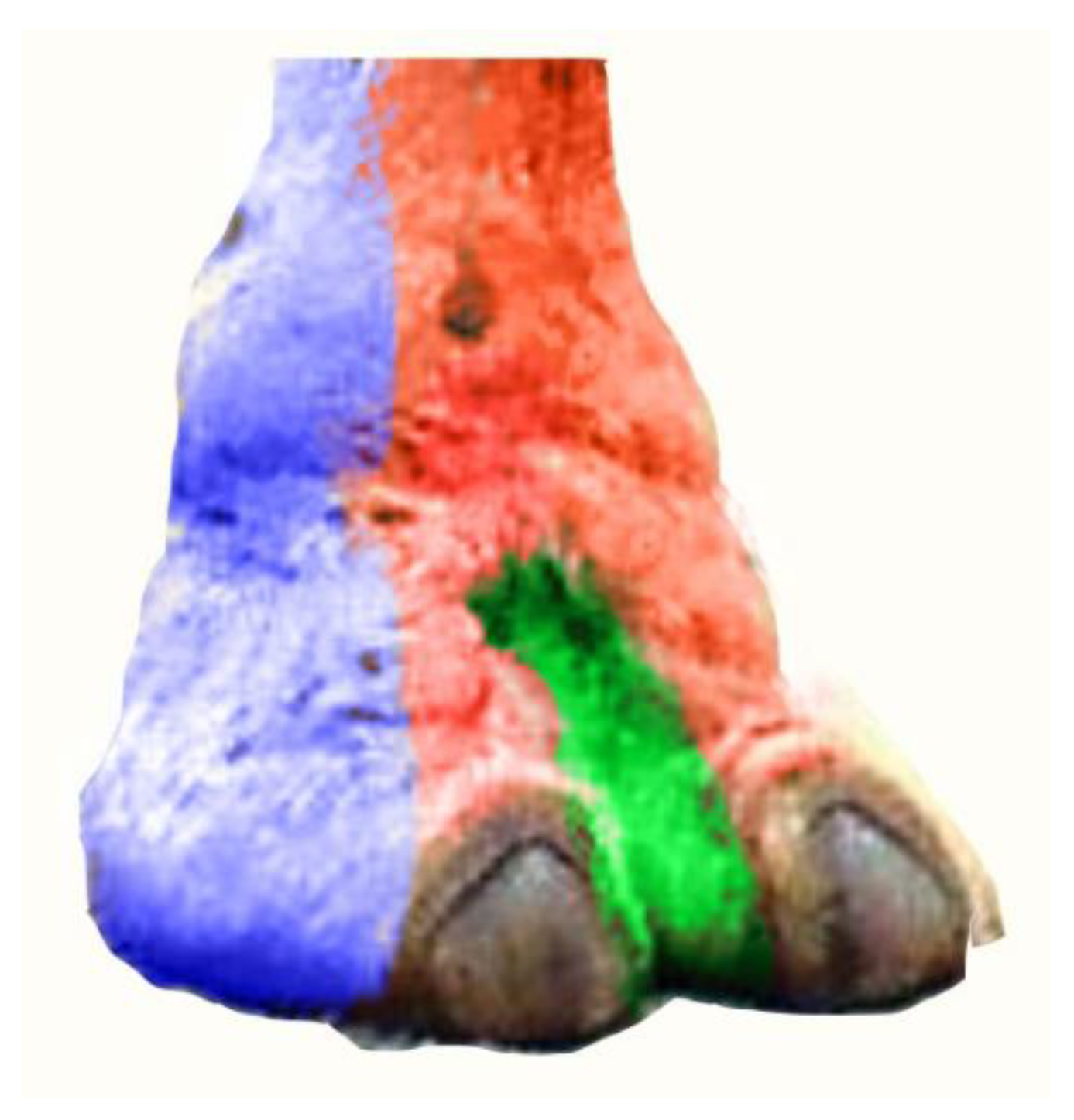
Disclaimer/Publisher’s Note: The statements, opinions and data contained in all publications are solely those of the individual author(s) and contributor(s) and not of MDPI and/or the editor(s). MDPI and/or the editor(s) disclaim responsibility for any injury to people or property resulting from any ideas, methods, instructions or products referred to in the content. |
© 2023 by the authors. Licensee MDPI, Basel, Switzerland. This article is an open access article distributed under the terms and conditions of the Creative Commons Attribution (CC BY) license (https://creativecommons.org/licenses/by/4.0/).
Share and Cite
Allouch, G.M.; Alshanbari, F.A. Anatomical Study of the Nerve Supply of the Dromedary Camel (Camelus dromedarius) in the Distal Hindlimb with a Special Reference to the Cutaneous Innervation. Vet. Sci. 2023, 10, 305. https://doi.org/10.3390/vetsci10040305
Allouch GM, Alshanbari FA. Anatomical Study of the Nerve Supply of the Dromedary Camel (Camelus dromedarius) in the Distal Hindlimb with a Special Reference to the Cutaneous Innervation. Veterinary Sciences. 2023; 10(4):305. https://doi.org/10.3390/vetsci10040305
Chicago/Turabian StyleAllouch, Gamal M., and Fahad A. Alshanbari. 2023. "Anatomical Study of the Nerve Supply of the Dromedary Camel (Camelus dromedarius) in the Distal Hindlimb with a Special Reference to the Cutaneous Innervation" Veterinary Sciences 10, no. 4: 305. https://doi.org/10.3390/vetsci10040305
APA StyleAllouch, G. M., & Alshanbari, F. A. (2023). Anatomical Study of the Nerve Supply of the Dromedary Camel (Camelus dromedarius) in the Distal Hindlimb with a Special Reference to the Cutaneous Innervation. Veterinary Sciences, 10(4), 305. https://doi.org/10.3390/vetsci10040305





